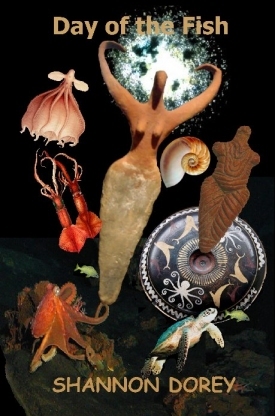
Introduction
The First Religion
The day of the Nummo's return was known to the Dogon as the "Earth of the Day of the Fish". The good Earth that the Nummo provided was to progressively extend itself over the Fox's Earth. The regeneration of the land was tied to the regeneration of humanity, and the Nummo believed that humans would find their way back to truth and immortality. "Humans after regeneration must be drawn towards the ideal as a farmer is drawn to rich farmland."
My research reveals that the African Dogon religion is the pagan mystery religion spoken about by the ancient Greeks, Celts, Romans, Egyptians and others, and which was thought to have been lost to humanity. I believe that this religion, still practised by the Dogon people in the 1930s and recorded by the anthropologists Marcel Griaule and Germaine Dieterlen, is the most important historical source document we have left in the world. This document, which records an oral religion that comes from the beginning of human civilization, reveals the truth about our existence.
Most of us have spent a great deal of time searching for the truth. This is because we inherently know that there is something missing from our existence. The time I have spent studying the Dogon religion has made me realize just how much of the truth has been taken from us and how new realities have been manufactured that are widely believed in today. I'm not sure how many of you are familiar with George Orwell's book 1984, but my research on the Dogon has reminded me of that book on more than one occasion. For those of you unfamiliar with the book, it is about a repressive, totalitarian regime that falsifies historical records in order to keep control over society. I believe that our own reality of truth is much like the individuals living in Orwell's book. The falsifying of our past has been an ongoing process and there have been many culprits along the way. One of the biggest is the Roman Catholic Church, whose oppression of other beliefs has been occurring since 391 CE, when the worship of any religion but Christianity was made illegal in the Roman Empire. In my view, the Dogon people have been the keepers of the truth, a truth that was stamped out in other areas by the Christian crusaders, the Inquisition, and the proselytizing of Jesuit priests around the world.
When I began researching the Dogon religion, I had no inkling of what I might be uncovering. When the reality of it became clearer, I felt as if someone had pulled the rug out from under me. It was as if everything I'd ever been told about history had been a disgraceful lie. This book is an exploration of human history and a journey of truth. It unravels the many lies that have been perpetuated against humanity throughout the ages. The Dogon religion is the only religion left in the world that tells us about the alien Nummo. Beings who were once at the base of human religion and at the core of human civilization. Beings who were almost completely stamped out of history and subsequently human consciousness. According to the Dogon, the spiritually advanced Nummo were a race of fish-like hermaphrodites who came to Earth for the benefit of humanity. The amphibious Nummo, who were described by the Dogon people as being more female than male, were immortal beings, who were identified with the sacred feminine. My research reveals that they were the Goddesses that were loved and revered by the people of Old Europe. Demonized by later patriarchal cultures, the Dogon tell us that these beings were responsible for human creation and civilization.
The primary mystery that permeates the Dogon religion is genetics. I could never have understood or begun to unravel the Dogon religion's mystery without having some knowledge of genetics. I believe that this religion was deliberately designed this way by the Nummo so that it could be understood once the study of genetics had been rediscovered by humanity. The Nummo probably knew that once we finally understood this religion and realized how interwoven it was with the rest of human history, that we would know without a shadow of a doubt, that it was the truth. We would know that it had been created by a far more scientifically advanced species. A species who not only loved and cared about our future but who had put a great deal of time and effort into preserving the truth for us.
To me this religion represents the alpha and the omega, the beginning and the end. It began with genetics and ends with genetics. The end however is simply the beginning and so we have come full circle and the circle is a symbol of immortality. I believe that it won't be long before scientists here will be able to regenerate the human body, much like the immortal Nummo could do. The Dogon religion reiterates the dangers involved in genetic engineering. It tells us that the spiritual and physical are intertwined in DNA, and that genetics is something that should be explored with caution. It reveals that humans are connected to all forms of life, involving a vibration that ties us to each other and to the rest of the universe. It tells us that we need to rekindle our connection to that vibration so that we can renew our love of the Earth and all the plants, animals and other species that live on the planet. Until we are able to do that, we will never truly find the spirituality that has been lost to us.
The Dogon believed that for humans to reach a complete state of knowledge, they had to understand all the signs and diagrams the Dogon taught in their religion. Once all these signs were understood, the truth would be revealed.
When the French anthropologists, Marcel Griaule and Germaine Dieterlen, began recording the Dogon religion in the 1930s and 40s, the Dogon were one of the last people in Africa to come under French rule. Prior to that time, the isolated Dogon had maintained their own beliefs and religious practices. The main reason that this religion has survived with the Dogon people is because they were living on the Cliffs of Bandiagara in Mali and were isolated from the rest of the world right up until the 1930s. Because the Dogon had been secluded, they were considered by the Europeans to be the most backward race in the whole region and the best example of "primitive savagery" known to the world. Muslim Africans also shared this view, as neither group could comprehend the Dogon traditions.Griaule p. 1.
This incomprehension is not surprising as the Dogon religion is so incredibly old that I believe it was created by the Nummo at a time when humanity was recovering from a cataclysm and had lost all of its former knowledge. It was the Nummo who told the Dogon about the time before the flood. The story about the lost continent of Atlantis in Plato's Timaeus was discussed in great detail in my first book The Master (Mistress) of Speech because of its similarities to events described by the Dogon. A world devastation before the flood, which is found in the ancient mythologies of many cultures, caused humans to lose their scientific knowledge. When the Dogon religion was created, humans were living in an oral culture as written language hadn't yet been rediscovered. The Dogon were still living in this oral culture when their religion was recorded in the 1930s and 40s.
It is difficult for those of us who have spent the majority of our lives living in a written culture to relate to an oral culture. And what about those from the Facebook generation, who have spent their entire lives in a digital culture, how can they possibly get their heads around an oral culture? The digital culture and the oral culture are completely opposite to one another. In an oral culture memorizing details is the only way that a society can preserve ideas. As a consequence, only the most important information is memorized and retold. Compare that to a digital culture where every idea that ever existed is stored in some electronic memory bank somewhere. Such trivial details as brushing your teeth appear on people's blogs and Facebook pages and are stored forever. Because they weren't able to write down information, people from oral cultures created techniques to help with memorization. What is remarkable is how complex some of the information is that was passed on using these techniques.
Antithesis, which is putting opposite ideas into passages, was one way to aid with memory. By doing this one line would act as a memory trigger for the next line. Symbols, which are concrete objects or images that represent something other than what they visually appear to be, such as abstract ideas, were used in oral cultures as a way of linking different stories and concepts together. Both symbolism and antithesis are found in this Dogon oral passage used to describe the main difference between an oral and written culture. It tells us why the information found in the Dogon religion is so important.
When the crop is backward and thin, the ears are light and move with the slightest breath of wind. Thin crops are therefore full of sound. An abundant crop, on the other hand, is weighed down by the wind and bows itself in silence.Griaule, p.23
Grain is a consistent symbol throughout the Dogon religion and represents human "seed." A crop therefore symbolizes a group of people. The light crop represents a less technical group of humans like the Dogon people in the 1930's. The heavy crop, on the other hand, represents a more technically advanced group like the Europeans in the same time period. This passage uses the antithesis of the thin, light crop that moves easily and is full of sound, in contrast to the heavy crop that is so weighed down that it bows itself in silence. In other words, a less technical culture, like an oral culture, is the light crop that has so little information in it that what is there is significant or full of sound. The European culture, on the other hand, even in the 1930's was weighed down by so much information that it was difficult to identify what was important. The digital culture takes that information overload one step further. The end result is that the heavy crop bows itself in silence.
As another way to help with memorization, people in oral cultures used objects found in everyday life to create symbols. This is no doubt why grain was used as a key symbol for human "seed". People in oral cultures also used metaphors as mnemonic aids. Metaphors imply comparisons between things that are different but which actually have similar characteristics. In this next oral passage, a weather metaphor is used in conjunction with antithesis to describe the eventual discovery of the truth by humans.
What is left-which is unknown-will be known later to man [humans] and will change the world. It is said that this revelation will come slowly at first like a fog, then swiftly like the rain and the wind.Dieterlen and Griaule p. 449
When I first began studying the Dogon religion, it was like looking through a fog. I could see glimpses of important information but I couldn't quite grasp their overall significance. As I studied and learned more about the symbols, I was able to compare them with other ancient religions and cultures. As the religion began to reveal itself to me, it happened swiftly like the rain and wind. It was as if whoever created both oral passages knew that someday they would be understood by some future generation and their significance would be evident. It was as if that very moment in time had been known since the beginning.
One of the most humorous lines I found while reading Griaule's book on the Dogon religion, Conversations with Ogotemmêli, was when the Dogon elder Ogotemmêli told Griaule, "Africans are creatures of light emanating from the fullness of the sun, while Europeans are creatures of moonlight." In the Dogon religion, the sun is a symbol of everything that is good, while the moon is a symbol of everything that is evil. I'm not sure Griaule would have included that line in his book, if he really understood its symbolic significance.
Even though the world's first religion only survived in fragmented pieces in other places of the world, the key symbols of this religion did survive and can be found everywhere. For instance, the symbols of the sun and moon are almost universally known. It is symbols like these that are our link with the truth and the very symbols on which the Dogon religion is based. It is these symbols that will guide you in your discovery of the truth, just as they guided me.
The Dogon had advanced knowledge of the solar system, which was incorporated into various religious symbols and rituals. This advanced knowledge, they said, had been given to them by the Nummo. One of the key rituals in the religion was the Dogon Sigui festival which was associated with the white dwarf star, Sirius B. This star was only detected by modern astronomers in 1862. The star's existence was first suspected in 1844 because of irregularities observed in the movement of Sirius A. Astronomers at the time determined that a second star must be causing the irregularity, and the star in question was finally detected in 1862. Even though Sirius B is invisible to the eye and so difficult to observe through a telescope that no photographs were taken of it until 1970, the Dogon understood the star's main properties in the 1930's, and said it was small, heavy, and white. According to Griaule and Dieterlen, there was evidence that the Dogon had been practising the Sigui ritual associated with the white dwarf star since at least the 13th century. They determined this date based on Dogon kanaga masks found stored in a cave in Ibi in 1931. It was the Dogon custom to carve one of these masks for each Sigui ceremony held once every sixty years. At that time, there were nine masks intact and at least three others, which had crumbled to dust. This would date the ceremonies back to the thirteenth century.Griaule and Dieterlen p. 14
As I referred to earlier, when I was reading Conversations with Ogotemmêli, I noticed that the sun was consistently used as a symbol to represent the Nummo and everything that was good. After a while the moon came into play, and I started to realize that the moon symbolized everything evil in the religion. The symbol of the sun was therefore connected to the symbol of the moon. One symbol fed off the other as a way of reinforcing their symbolic meaning. The symbols in turn were related to other symbols, so in the end you were left with a giant network of interconnected symbols. The importance of this model is that it isn't linear. It's like a circle, and how do you establish a beginning and end point on a circle? You can't. According to Ogotemmêli, the Nummo were immortal beings and I think that the structure of this religion provides us with a metaphor for immortality.
Humans create stories that have linear formations. They have a beginning and an end. This is indicative of our mortal perception of the universe. We are born, we live, and we die. Because the Nummo are immortal beings, they are still in existence today, just as they existed thousands of years ago, and just as they will still exist when we have long since turned to dust. Immortal beings live forever, which is difficult for us to understand.
There is a jellyfish known as the Turritopsis nutricula, which is identified as being biologically immortal.http://en.wikipedia.org /wiki/Immortality "After becoming a sexually mature adult, the jelly fish can transform itself back into a child (the polyp stage) using a cell conversion process known as transdifferentiation." (Transdifferentiation in biology takes place when a non-stem cell transforms into a different type of cell, or when an already differentiated stem cell creates cells outside its already established differentiation path.)http://en.wikipedia.org/ wiki/Transdifferentiation By repeating the process it can essentially live forever.http://en.wikipedia.org /wiki/Immortality
The Nummo were amphibious androgynous beings and perhaps they once regenerated themselves much like these jelly fish do. This was no longer the case by the time they came to Earth. Ogotemmêli indicated to Griaule that the Nummo's world had been physically dying, which is why some of them came here. Perhaps they could no longer physically regenerate themselves. Even though the Nummo were immortal and more advanced spiritually than humans, they were like humans in the sense that their bodies physically lived and died. Unlike humans, however, who can't remember from one life time to the next, the Nummo were always conscious and present. Ogotemmêli described life and death for the Nummo as being similar to a snake shedding its skin. Because their bodies lived and died, the Nummo still needed to be reborn in order to physically exist.
There wasn't any intelligent life on the planet when the Nummo first came here. It was their plan to genetically modify their bodies so that they could better adapt to living on the Earth. It is possible that they needed to be genetically tied to the Earth so they could spiritually connect with the plants and animals that exist here. According to Ogotemmêli, they combined their DNA with those of the animals, plants and other organisms that lived on the Earth. They assumed that their superior immortal essence would be transferred, through their DNA, to the new world they were creating. What the Dogon religion tells us is that their experiment failed. Nummo souls were lost to the Earth, and the experiment resulted in the birth of a single-sexed male being known as the Jackal. The single-sexed male Jackal, who symbolized the first humans, was born mortal without any knowledge of a previous existence and was separated from the hermaphroditic Nummo's immortal essence.
As self-fertilizing amphibians, the Nummo's method of reproduction may have been more complex than the Earth animals that they used for their experiments. In my first book, The Master (Mistress) of Speech, I discussed the reproductive methods of the killifish to try to explain what may have happened to cause the Nummo's experiment to fail. The killifish, who are self-fertilizing hermaphrodites like the Nummo, are native to the mangrove swamps of Florida and the Caribbean. Males are only born occasionally as a means of providing genetic diversity to the species. When the Nummo combined their DNA with the terran animals, the experiment appeared to succeed, and the first creatures were born self-fertilizing and immortal like the Nummo. Compared to the killifish, these individuals represented about 85 per cent of the species. It wasn't until after the birth of a single-sexed male that it became evident the experiment had failed. The single-sexed males, if compared with the killifish, represented about 15 per cent of the population, and these Nummo/human hybrids were born mortal with no knowledge of a previous existence.
Ogotemmêli described the first biological experiment, which involved a union between the Nummo and the Earth, as resulting in the birth of two types of Earth animal/Nummo hybrids. One offspring was born "normal" like the Nummo, meaning it was an immortal androgynous or a "twin" Nummo. The other offspring, however, was a single-sexed male known as the Jackal.Griaule p. 167 Throughout the religion, references to "twinness" represented self-fertilizing androgyny. Even though the "twin" Nummo were identified as being self-fertilizing androgynous beings, the Dogon people perceived them as feminine. They were identified with the sun, which was a female symbol. The Jackal, on the other hand, who was the defective offspring, was identified with the Earth and the moon, which were male symbols.
The single-sexed male's birth defect affected the "course of things forever" and symbolized the Nummo's difficulties.Griaule p. 17 There was the fear that by breeding with the Jackal, who was morally and spiritually inferior to them that it would cause the Nummo to lose their own immortality. There was the sense that the Nummo were able to communicate with each other and with other animals and plants on a level unknown to humans. Because the Jackal did not have this connection, Ogotemmêli said he was "alone from birth."
From these first offspring then, the Dogon perceived the androgynous human/Nummo hybrid as feminine and good, while the brother (the Jackal) was perceived as having been born soulless. It was this problem of "twin births" versus "single births," or androgyny versus single-sexed beings, that contributed to the disorder at the beginning of time. This theme became a significant basis of the Dogon religion.
Although he was referred to as the Jackal, this first single-sexed male human was associated with an ant. In the Dogon religion, the place where the experiments occurred was underground in Earth mounds, in what the Dogon referred to as "anthills".Dorey, The Master (Mistress) of Speech p. 114 The Dogon associated the failed experiment with the raping of the Earth. In this respect, Mother Earth was an ant, who became dominated and raped by her son the Jackal. "The Jackal was alone from birth," said Ogotemmêli, "and because of this he did more things than can be told."Griaule p. 22 As a result of this separation from the Nummo, the Jackal ended up stealing a Nummo spaceship and crashing it into the Earth, creating a worldwide devastation. The mythology hints at the fact that there were a number of male individuals like the Jackal, who destroyed life on the Earth. The Jackal was associated with death and mortality. One of the Dogon funeral chants refers to the destruction of the Earth by the Jackal. In the chant, the Earth animals and the Jackal are described as a column of ants.
The column of ants has got up on the roof! The column of ants has destroyed the house! Has got up on the roof! It is the ants which have destroyed the father's [mother's] house!Dorey, The Master (Mistress) of Speech p. 43-44
The same story appears in Greek mythology, where the first humans crawled out of the Earth as an entire people, not as human beings but as ants.Dorey, The Master of Speech p. 112-113
…it was not only the Athenians but the inhabitants of the island of Aigina (Aegina) who were said to have crawled out of the earth as an entire people-which they did, in any case, not as human beings, but as ants. It was told that after the goddess Aigina (Aegina) had borne Aiakos (Aeacus) to Zeus, her son was left entirely alone on the island. When he had grown up to be a youth he found this solitude wearisome. Thereupon Zeus turned the ants on the island into men and women, and bestowed upon Aiakos (Aeacus) the people of the Myrmidons- a name that sounds like murmekes, 'ants'. It was this people that built the first ship.
In the Greek myth, the Jackal figure was Aiakos, who was left entirely alone on the island. The Dogon indicated that the Jackal was alone because he was disconnected from the Nummo's spiritual essence. In the Greek myth, it was Aiakos loneliness that caused the Greek god Zeus to turn the ants into men and women. In the Greek story, the people crawled out of the earth as ants.Dorey, The Master of Speech p. 112-113
The Hopi, who are descended from the Ancient Pueblo Peoples, also have legends involving the "Ant People". The Hopi are known for their "construction of large apartment-house complexes in northeastern Arizona, northwestern New Mexico, and southwestern Colorado."https://en.wikipedia.org/wiki/Hopi Like the Dogon, the Hopi describe the world as having been destroyed by fire.
Gary A. David writes about the Hopi's beliefs regarding the "Ant People".
One of the most intriguing Hopi legends involves the Ant People, who were crucial to the survival of the Hopi-not just once but twice. The so-called "First World" (or world-age) was apparently destroyed by fire-possibly some sort of volcanism, asteroid strike, or coronal mass ejection from the sun. The Second World was destroyed by ice-Ice Age glaciers or a pole shift. During these two global cataclysms, the virtuous members of the Hopi tribe were guided by an odd-shaped cloud during the day and a moving star at night that led them to the sky god named Sotuknang, who finally took them to the Ant People-in Hopi, Anu Sinom. The Ant People then escorted the Hopi into subterranean caves where they found refuge and sustenance.David, Gary A. The Ant People of the Hopi, Oct. 13, 2013 http://www.ancient-origins.net /myths-legends-americas- opinion-guest-authors/ ant-people-hopi-00927
On the Celtic Greek island of Aegina, where the story about the ant people was told, there exists various artifacts reminiscent of the symbolism found in the artifacts of the Indigenous Peoples of the Americas.
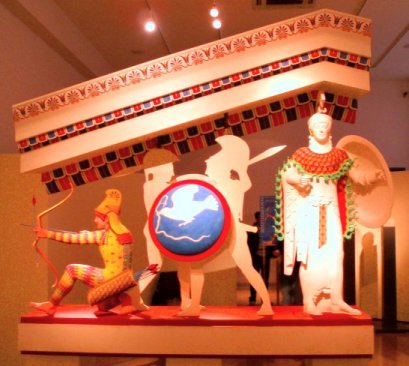 Figure A-1. Artifacts from AeginaCreative Commons Attribution-Share Alike 2.5 Generic. Author: Marsyas Coloured reconstruction of the West pediment of the Athena Aphaia Temple in Aegina. ca. 490. From the ''Bunte Götter''/Polychromoi Theoi exposition in Athens, 2007. Photograph taken by Marsyas https://commons.wikimedia. org/wiki/File:NAMABG-Athena _Aphaia-W_Pediment_colored.JPG |
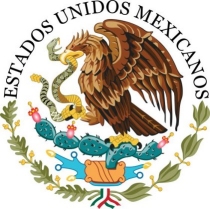 Figure A-2. Mexican Coat of ArmsBy Alex Covarrubias. Based in the arms of Juan Gabino. - Coat of arms of Mexico.svg, Public Domain, https://commons.wikimedia .org/w/index.php?curid =2872123 |
Figure A-1 is a shield of an eagle with a snake in its mouth, which appears in the west pediment of the temple of the goddess Aphaia Athena (goddess shown to the right in Figure A-1) ca. 490 in Aigina. A similar image appears on the coat of arms of Mexico (Figure A-2). A peacock, which later became a symbol of Christ, holds a serpent in its mouth in the Celtic Book of Kells.Shannon Dorey, The Nummo. Elemental Expressions Ltd. Elora, Ontario. 2012. p. 42. Other depictions from Aigina including a boar and a double headed eagle are found in the religious artifacts of the Indigenous Peoples of the Americas. The symbols found in the Dogon religion are very close to the Celtic religion and Celtic and Dogon symbols are found extensively in the Americas including serpents, foxes, fish, frogs, boars, turtles, bears, cats, owls, two headed figurines, and a siren (a bird with a human head), Figure A-3.
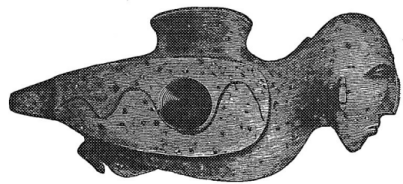 Figure A-3 Siren, Mississippi ValleySquire, E.G. and Davis, E.H., Ancient Mounds of the Mississippi Valley, 1847 p. 247 Fig. 147. Found in ancient enclosure 12 miles below the city of Chillicothe. |
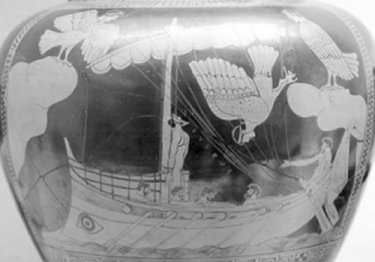 Figure A-4 Odysseus and the SirensBy English: Siren Painter (eponymous vase) - Jastrow (2006), Public Domain, https://commons.wikimedia .org/w/index.php?curid =1517690 |
Figure A-3, which is considered a relic of the Mississippi Valley mound builders and identified as a shaman, was found in an ancient enclosure 12 miles below the city of Chillicothe, Ohio. Adapted as a pipe, it was made of fine porphyry of a greenish brown or lead color interspersed with black and white granules of a harder substance. The figure has its eyes closed and the ears are mutilated. Wings are shown closely folded and the figure measures about five inches in length. Figure A-4 is a Greek vase depicting Odysseus and the Sirens, by the Siren Painter, c. 480-470 BCE (British Museum).
The Celtic religion has many parallels with the Dogon religion suggesting a common belief system. My research reveals that these beliefs once stretched from the United Kingdom and Ireland to China, Japan, Turkey and into the Americas. (Refer to The Nummo for other Dogon and Celtic similarities found in Mexico.) The Celtic and Dogon finds in the Americas indicate that Indigenous Peoples practised this ancient religion, which seems to have been a combination of Celtic and Dogon beliefs, before they were isolated from the rest of the World at the height of the last ice age or Last Glacial Maximum.
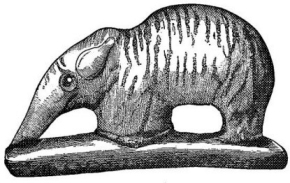
Figure A-5 Mastodon Pipe From IowaHenshaw, Henry, W. Animal Carvings From Mounds of the Mississippi Valley, 1880-1881 p. 152
According to Ariane Burke of the University of Montreal's Department of Anthropology, studies in population genetics have shown that a group of a few thousand individuals lived in isolation from the rest of the world in Beringia 15,000 to 24,000 years ago. Beringia is a vast region stretching from the Mackenzie River in the Northwest Territories to the Lena River in Russia. Doctoral student Lauriane Bourgeon examined artifacts found in the Bluefish Caves, located on the banks of the Bluefish River in northern Yukon near the Alaska border to confirm the Beringian genetic isolation hypothesis. The Beringians of Bluefish Caves were among the ancestors of people who, at the end of the last ice age, colonized the entire North American continent along the coast to South America.https://phys.org/news /2017-01-humans-north-america -years-earlier.html First Humans Arrived in North America 10,000 years earlier than believed January 16. 2017 Phys.org These findings support my research that the Celtic and Dogon religions were the earliest religions on Earth and that they were closely associated and well established before this separation took place.
Another carving found in the mounds of the Mississippi Valley, which substantiates the age of the mounds, is the Mastodon, Figure A-5. This animal was referred to by Henry W. Henshaw in a report sent to the Secretary of the Smithsonian Institution in the early 1880s. Henshaw also made reference to the "Elephant Mound" found in Wisconsin. There were two pipes found in Iowa that resembled the Mastodon.Henshaw, Henry, W. Animal Carvings From Mounds of the Mississippi Valley, 1880-1881 p. 152 Henshaw tried to disprove the fact that the Mound-Builders lived at the same time as Mastodons, by first trying to discredit the people who had found the carvings and then by suggesting that the extinction of the Mastodon was "certainly a very recent event, and, as an antiquity of upwards of a thousand or more years has been assigned to some of the mounds, it is entirely within the possibilities that this animal was living at the time these were thrown up." Current theories claim that Mastodons went extinct at the end of the Pleistocene 10,000 to 11,000 years ago at the same time as the Woolly Mammoth, shortly after the last Ice Age.https://en.wikipedia.org /wiki/Mastodon
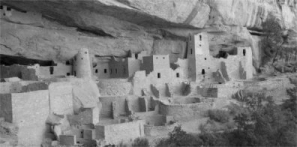
Figure A-6 Cliff Palace, by To-Chau TranBy To-Chau Tran (Own work) [CC BY-SA 3.0 (http://creativecommons.org /licenses/by-sa/3.0)], via Wikimedia Commons https://commons.wikimedia.org /wiki/File%3ACliff_Palace_ (Mesa_Verde)%2C_A_wonder_of_A merican_Southwest.jpg (Reverted to Black and White. Cropped and Reduced).
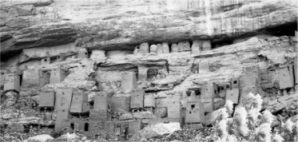
Figure A-7 Cliff of Bandiagara, by Olivia Epron[CC BY-SA 3.0 (http://creativecommons.org /licenses/by-sa/3.0) via Wikimedia Commons by Olivier EPRON https://upload.wikimedia. org/wikipedia/commons/7/ 76/Falaise_de_Bandiagara.png
When I first saw a picture of the Cliff Palace of the ancient Pueblo People, in Mesa Verde National Park, Colorado (Figure A-6), I thought I was looking at Dogon dwellings found on the Cliffs of Bandiagara in Mali, Africa (Figure A-7). Today there are "21 surviving pueblos in the Southwest of the United States. Taos, Acoma, Zuni and Hopi are the best known.https://en.wikipedia.org/ wiki/Puebloans In Dogon families, kingship was through the women and the maternal uncle played an important role.Griaule and Dieterlen p. 43 The Hopi are likewise organized into matrilineal clans.https://en.wikipedia.org /wiki/Hopi This is important because it highlights the age of these religions. According to the research of Marija Gimbutas, Joseph Campbell, Robert Graves and others, the earliest cultures in the world were matriarchal. Many of the Dogon symbols identified with the Nummo are the same symbols that Marija Gimbutas, a Lithuanian-American mytho-archeologist, associated with the Goddess of Old Europe.
In this book, I have focused on Gimbutas' research on the Goddess because so much of what she discovered relating to the Goddess religion also applies to the Dogon religion. During her extensive research on the Goddess, Gimbutas saw differences between the Old European system, which she identified as being female and Goddess centered, and the Bronze Age Indo-European patriarchal culture which supplanted it. Her work on Old Europe is often viewed as controversial because of its emphasis on a female focused culture based on equality. This differed from the later patriarchal cultures with their male-dominated hierarchical societies. The primary difference between the image Gimbutas projected of the Goddess of Old Europe and how Ogotemmêli described the Nummo, is that the Nummo weren't strictly female beings, they were hermaphrodites. Although they were considered more female than male, the Nummo had both male and female genitalia. They were self-fertilizing, which I believe resulted in the myth of the Virgin Goddess.
My research shows that many of the female symbols associated with the Nummo were reversed by later patriarchal cultures. The patriarchal fathers from warring tribes whose traditions have come down to us in Judaism and Christianity, as well as in the Greek and Roman myths, didn't like the fact that the male figure was associated with evil in the earlier religion. It was these male leaders who were responsible for reversing the earlier religious symbols. The great mythologist Joseph Campbell refers to this moment in history as the birth of the Sun God.
And the celestial orb to which the monarch is now likened is no longer the silvery moon, which dies and is resurrected and is light yet also dark, but the golden sun, the blaze of which is eternal and before which shadows, demons, enemies, and ambiguities take flight. The new age of the Sun God has dawned, and there is to follow an extremely interesting, mythologically confusing development (known as solarization), whereby the entire symbolic system of the earlier age is to be reversed, with the moon and the lunar bull assigned to the mythic sphere of the female, and the lion, the solar principle, to the male.Campbell, The Masks of God Accidental Mythology. (Markham, Ontario, Canada. Penguin Book Canada Ltd. 1976. First Published in 1964.) p. 75.
These changes never occurred in the Dogon religion. The immortal, primarily female, hermaphroditic Nummo were still identified with the sun in the 1930's when Griaule and Dieterlen first encountered the Dogon. Lébé, a key figure in the religion, who was primarily female, was still symbolized by the lion. The single-sexed male Jackal or ant, who represented the negative element in the religion, was still symbolized by the moon. If changes like those described above had been made, the unfortunate result would have no doubt meant that the Nummo and Lébé would have been portrayed as single-sexed males. The Jackal, on the other hand, would have been identified as an evil female, who was symbolized by the moon, and the importance of hermaphroditic beings to human origins would have never been known.
One of the most important aspects of the Dogon religion, in comparison to other ancient cultures recorded by historians and anthropologists, is that the Dogon were still practising their religion at the time it was recorded. Unlike the religion of the Goddess that Gimbutas tried to piece together based on ancient artifacts, the Dogon were a living society. Ida Moffet points this out in her introduction to The Pale Fox, translation of Griaule and Dieterlen's work, published in 1965:
…the Dogon are a living society; their body of myths, instead of being the static lore of an extinct people is the most active driving force of their existence. …every aspect of individual life and of social institutions is modeled on their cosmogony in all its phases and permutations…. The stars are inspirited components of a dynamic whole among which there is a constant exchange of energies; for like the ancient astronomers/astrologers, such as the Chaldeans, Chinese, Celts, Mayas and other Amerindians, the Dogon are scientists and hierophants at the same time and thus concerned with both the physical and metaphysical realities of the universe.Dieterlen and Griaule. p. 15.
Even though the inner mysteries of the Dogon religion were only written down for the first time in 1946, my research reveals it to be an extremely ancient oral tradition that was known to all humans at one time. Because the Dogon religion is so interwoven with every major religion in the world, it is easy to get lost inside it. There is no easy path to the truth. It is a complex journey that I hope my experience and research can help you with as you weave your way through it. Think of it as the ball of thread that you can unwind on your way into the labyrinth. It will be there for you so that once you get to the centre of it and have faced the Minotaur, you can use it to find your way back out again. I believe that by taking this journey together we can get to the truth about our past, understand our present, and find a new spirituality for our future.
Softcover $31.49 USD + ShippingEEL Publishing 2022 (Second Edition)
Pages: 431 Size: 6 x 9
ISBN: 978-0-9950405-7-1
PDF: $14.99 USD
PDF format (Read Only)
ISBN: 978-0-9950405-8-8
(Please allow 24 hours for processing)